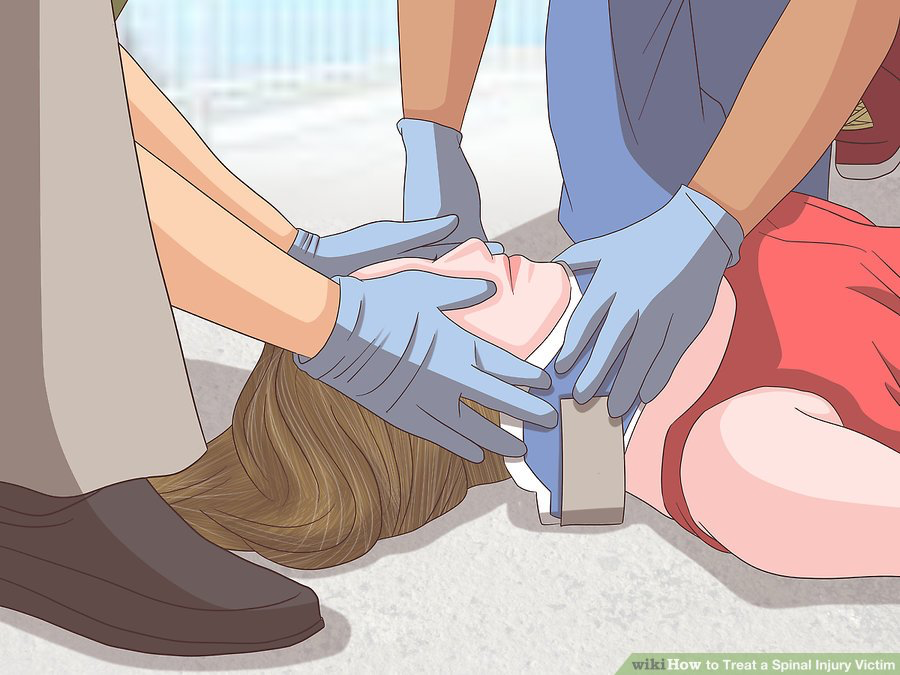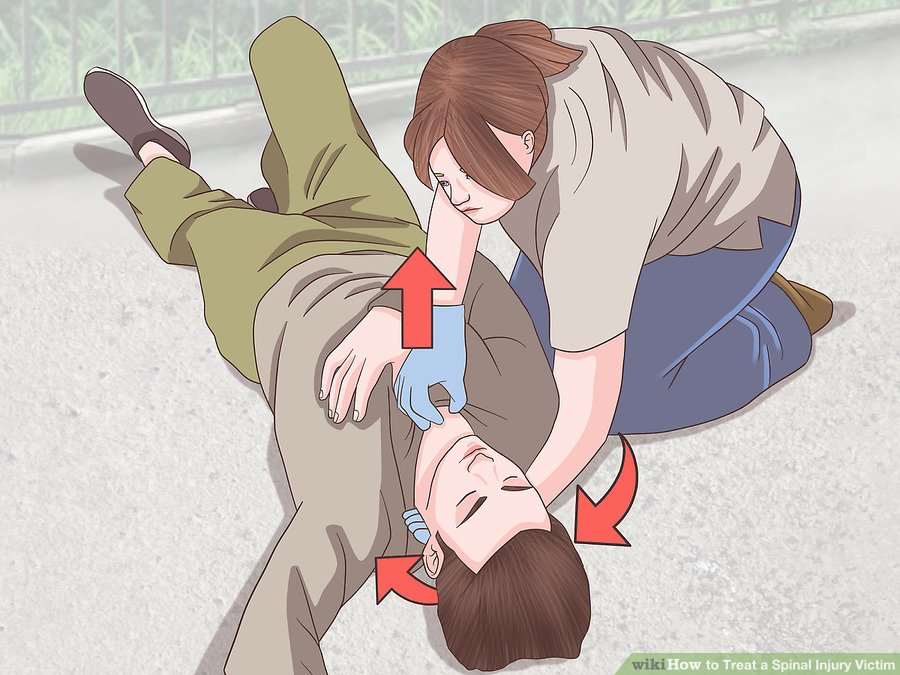First Aid Explained
Disclaimer:
This website is intended to assist with patient education and should not be used as a diagnostic, treatment or prescription service, forum or platform. Always consult your own healthcare practitioner for a more personalised and detailed opinion
How to Treat a Spinal Injury Victim

We have selected the following expert medical opinion based on its clarity, reliability and accuracy. Credits: Sourced from the website wikiHow. Please refer to your own medical practitioner for a final perspective, assessment or evaluation.
Overview
Some injuries can cause damage to a person?s spinal cord, that delicate nerve system in the neck and spine responsible for sensation and muscle movement. Spinal injuries are very serious and can lead to permanent disability, paralysis, or even death. In an emergency situation when the victim may have a spinal injury, you should avoid worsening damage to the spinal cord however possible. Accidents happen, but knowing how to properly treat someone who has had or might have a spinal injury could save someone?s life and help prevent irreparable damage.
1: Responding in an Emergency
1. Treat anyone with a head injury as if they have a spinal injury
The best rule about assessing whether a victim has a spinal injury is to assume that they do. This is because the consequences of spinal injury are severe and usually permanent, and mistreating someone with a spinal injury - even if you have the best intentions - can seriously worsen the injury and outcome. Any victim with an injury to their head, neck or back should automatically be treated as if they have a spinal injury.
- Recognize that head wounds can come from many types of injuries, and you will not always see blood or an open wound when someone has hit their head. Diving into shallow water, for instance, may be an unsuspected source of spinal injury.
2. Do NOT move the victim
Any movement of the injured person can cause worse damage to their spinal cord. The only time you should ever move a potential spinal injury victim is if they are in immediate danger, such as in a burning house or car. If you are both in a safe environment, leave them exactly where they are and allow medical professionals to move them.
- If the victim was wearing a helmet at the time of injury, such as during sports or in a motorcycle accident, do not remove the helmet. This should be done by professionals.
3. Call for emergency services
Medical professionals will be better able to assess and manage potential spinal injuries, and will have backboards and special equipment for moving people with these injuries. Contacting emergency medical personnel should be done immediately, assuming you and the victim are in no immediate danger.
- When calling for medical aid, inform staff that you are dealing with a victim of a spinal injury. They will be able to give you more advice on how to take care of the victim.
4. Give CPR if necessary
Observe whether the victim is breathing on their own, as spinal injury can sometimes affect ability to breathe spontaneously. Look to see if their chest is rising with breath, or feel under their nose for air. The only time you should move the victim's head - short of being in immediate peril - is if you have to provide the rescue breathing or chest compressions of CPR. This can be a life-saving measure until emergency medical care arrives.
- If the victim's heart is beating but they are not breathing, provide rescue breaths; if they have no pulse, focus on high-quality chest compressions.
- To give rescue breaths, do NOT lift the victim's chin to open an airway if you can avoid it. Instead perform what is called the Jaw Thrust maneuver: Kneel at the top of the victim?s head, use both hands one on each side to hold the angles of their lower jaw, and lift upward with both hands. This technique may be slightly safer for spinal injury victims. Unfortunately, this requires a second person present to perform the rescue breathing while you hold the jaw upward.
- If they do not need CPR, you can then - without moving the victim - look them over to see if they have any other obvious severe injuries. Apply pressure to wounds that are heavily bleeding.
5. Note the cause of the injury
The most common cause of spinal injury in persons under age 65 is vehicular accidents. Other common causes are falls, gunshot and knife wounds, playing sports without appropriate safety equipment (especially American football), and injury sustained while under the influence of alcohol. Be on high alert for potential spinal damage with any of these injuries, and treat the victim accordingly. It may also help medical staff if you can tell them what caused the injury.
6. Recognize symptoms of spinal injury
If no healthcare professional is on site, you can evaluate the victim for signs and symptoms of spinal injury. First observe the victim - if they are unconscious or only somewhat conscious, their neck or back is at a strange angle, or they have lost control of their bladder or bowels and soiled themselves, assume spinal injury. Also treat them as if they have spinal injury if they won't or can't move their neck, seem to have trouble breathing, or they tell you they have intense pain in their neck, back or head. Another tell-tale sign of spinal injury is change in strength or sensation in their limbs.
- Spinal injury can cause weakness in any part of the body, as well as paralysis ? the inability to move at all, or move part of the body. Depending on the location of the injury, the patient will be affected in all four limbs, only on one side of the body, or in some or only one limb.
- Limbs can experience a number of sensation including numbness, tingling, pain, or a strong stinging. Loss of sensation can involve inability to distinguish temperature or feel touch.
7. Stabilize the victim until help arrives
Keep the victim totally still until professional help arrives. Hold their head and neck to prevent them from moving until emergency care arrives. Attempt to calm the victim by assuring them that help is on the way, and encourage them in a calming voice to stay completely still.
- Tell them gently but firmly, ?You may be badly injured. I?m here and professional help is on the way, but I need you to stay nice and still right now.?

2: Moving the Victim When Absolutely Necessary
1. Pull the victim by their clothing
In a situation that absolutely requires you to move the victim, do it in the least damaging way possible. Grab their shirt collar and use your forearms to support their head while pulling the body in a straight line. This is a preferred method as the victim's head is braced while moving.
2. Pull the victim by their arms or legs
Alternately, hold the victim and pull them by both feet, both shoulders, or both arms pulled over their shoulders. Do NOT pull by one arm or leg, as this will twist the body.
3. Keep their neck and torso straight and pull them in a straight line
Do not pull the body sideways! Emergency medical staff immobilize the spine with a rigid neck collar and a carrying board. If you must move the body, simulate this type of support by pulling the body only straight. The goal is to minimize movement in the neck and spine as much as possible.
- If injury occurs in the water, keep the victim afloat until someone can obtain a rigid board to slide under their head and torso as far down as their buttocks. If you can?t get a board, get help from other people to get the victim out of the water by moving them as one unit. Support their head and body, as if on a stiff board, and don?t let their neck bend or rotate.
4. Use at least two people if you must roll the victim over
If you must roll a spinal injury victim over to prevent choking on blood or vomit, get a second person to help you. Coordinate your timing so that you roll the victim over in such a way that the neck, back, and torso move as one unit. Do not allow the body to twist.

3: Treating Late Symptoms of a Spinal Injury
1. Monitor injured victims for late signs of spinal injury
Though many victims of head or neck trauma experience immediate symptoms of spinal injury, this is not always the case. Sometimes there are no immediate signs but as bleeding and swelling put pressure on the spinal cord, symptoms develop. Victims of potential injury should be monitored closely.
It's best to go to the hospital right after injury, but if not then seek immediate medical care if the injured person develops late symptoms of:
- Changes in sensory perception, like numbness and paralysis, which may worsen gradually.
- Gradual inability to control bladder or bowel, such as ?leaking? urine or becoming incontinent.
- New onset of erectile dysfunction or changes in genital sensitivity.
- Increased or new difficulty with walking, balance or coordination.
2. Obtain diagnostic imaging
If you or a loved one are at risk of spinal injury after an accident, go to the emergency room or at least see your doctor for testing. Your family doctor can perform sensorineural testing, manually testing muscle strength and ability to feel light touch. More definitive tests are CT scans, X-rays, and MRIs.
3. Participate in ongoing rehabilitation
The injury victim of spinal trauma will initially be stabilized in the hospital. After the hospital stay, however, long-term rehabilitation will begin. The rehabilitation team can involve physical therapists, occupational therapists, psychologists, psychiatrists, nurses, nutritionists, and social workers. This can be a physically and emotionally challenging time for the victim.
- Provide emotional support and help however you can, whether that's making frequent visits to play cards, walk the victim's dog, preparing meals, or just being available to talk about their struggles.
_______________________________________________________________________________________________________________________
Are you a healthcare practitioner who enjoys patient education, interaction and communication?
If so, we invite you to criticise, contribute to or help improve our content. We find that many practicing doctors who regularly communicate with patients develop novel and often highly effective ways to convey complex medical information in a simplified, accurate and compassionate manner.
MedSquirrel is a shared knowledge, collective intelligence digital platform developed to share medical expertise between doctors and patients. We support collaboration, as opposed to competition, between all members of the healthcare profession and are striving towards the provision of peer reviewed, accurate and simplified medical information to patients. Please share your unique communication style, experience and insights with a wider audience of patients, as well as your colleagues, by contributing to our digital platform.
Your contribution will be credited to you and your name, practice and field of interest will be made visible to the world. (Contact us via the orange feed-back button on the right).











